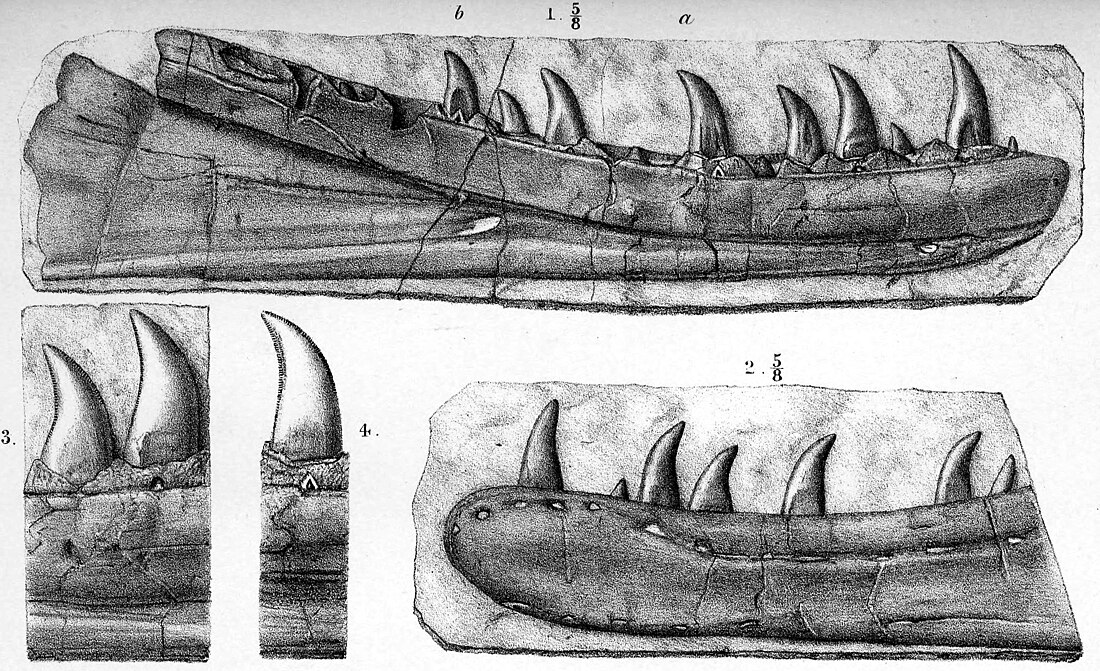镰齿龙属(属名:Zanclodon)意为“镰刀牙齿”,化石其实来自于至少两属恐龙,年代为三叠纪晚期,约2亿3700万2亿3500万年前[1]。Parrish在1993年,Nesbitt在2005年,以及Nesbitt与Norell在2006年,提出镰齿龙属于恐龙,并分类于Suchia的分类未定属。镰齿龙原先被分类于兽脚亚目的巨齿龙科。但巨齿龙科现在被归类于劳氏鳄目
Quick Facts 科学分类, 模式种 ...
镰齿龙属
|

|
科学分类 
|
| 界:
|
动物界 Animalia
|
| 门:
|
脊索动物门 Chordata
|
| 纲:
|
爬行纲 Reptilia
|
| 演化支:
|
真爬行动物 Eureptilia
|
| 演化支:
|
卢默龙类 Romeriida
|
| 亚纲:
|
双孔亚纲 Diapsida
|
| 演化支:
|
新双弓类 Neodiapsida
|
| 演化支:
|
蜥类 Sauria
|
| 演化支:
|
主龟龙类 Archelosauria
|
| 下纲:
|
主龙形下纲 Archosauromorpha
|
| 演化支:
|
鳄脚类 Crocopoda
|
| 演化支:
|
主龙型类 Archosauriformes
|
| 演化支:
|
真鳄脚类 Eucrocopoda
|
| 演化支:
|
镶嵌踝类 Crurotarsi
|
| 演化支:
|
主龙类 Archosauria
|
| 属:
|
†镰齿龙属 Zanclodon
Plieninger, 1846
|
| 模式种
|
镰齿龙
Zanclodon laevis
Plieninger, 1846
|
| 种
|
|
见本文
|
Close
模式种是Zanclodon laevis,化石是一块左上颌骨,目前只能确定属于主龙类,但无法确定详细的分类位置[2][3]。
镰齿龙是在1846年被叙述、命名,最初被命名为Smilodon,但哺乳类斯剑虎已使用这个学名,因此被重新命名为Zanclodon。镰齿龙一度有接近10个种,目前多半被归类于板龙、牛顿龙或蜥脚形亚目的分类未定位属。镰齿龙有非常复杂的分类历史,曾经被归类为板龙、巨齿龙的次异名,或是疑名、不确学名(Nomen vanum)。镰齿龙的分类也有争议,曾经先后被归类于蜥蜴亚目、斑龙科、板龙科、镰齿龙科(Zanclodontidae)、以及近蜥龙类[4][5][6]。
Hungerbühler, A. 2001. The status and phylogenetic relationships "Zanclodon" arenaceus: the earliest known phytosaur? Palaontologische Zeitschrift 75(1): 97–112.
Schoch, R.R. 2002. Stratigraphie und Taphonomie wirbeltierreicher Schichten im Unterkeuper (Mitteltrias) von Vellberg (SW-Deutschland). Stuttgarter Beiträge zur Naturkunde (B) 318: 1–30.
F. A. Quenstedt. 1867. Handbuch der Petrefactenkunde [Handbook of Fossils]. H. Laupp'schen Buchhandlung, Tübingen 1-1239
R. Lydekker. 1888. Catalogue of the Fossil Reptilia and Amphibia in the British Museum (Natural History). Part I. Containing the Orders Ornithosauria, Crocodilia, Dinosauria, Squamata, Rhynchocephalia, and Proterosauria. British Museum (Natural History), London 1-309
D. Naish and D. M. Martill. 2007. Dinosaurs of Great Britain and the role of the Geological Society of London in their discovery: basal Dinosauria and Saurischia. Journal of the Geological Society, London 164:493-510.
- Benton, M.J. 1986. The late Triassic reptile Teratosaurus – a rauisuchian, not a dinosaur. Palaeontology 29: 293–301.
- E. Fraas. 1900. Zanclodon schützii n. sp. aus dem Trigonodusdolomit von Hall [Zanclodon schützii n. sp. from the Trigonodus-dolomite of Halle]. Jahreshefte des Vereins für Vaterländische Naturkunde in Württemberg 56:510-513
- Galton, P.M. 2001. The prosauropod dinosaur Plateosaurus Meyer, 1837 (Saurischia: Sauropodomorpha; Upper Triassic). II. Notes on the referred species. Revue Paléobiologie, Genève 20(2): 435–502.
- O. Jaekel. 1910. Ueber einen neuen Belodonten aus dem Buntsandstein von Bernburg [On a new belodontid from the Buntsandstein of Bernburg]. Sitzungsberichte der Gesellschaft Naturforschender Freunde zu Berlin 1910(5):197-229
- Koken, E., 1900, (Review of E. Fraas: Die schwabischen Trias-Saurier, etc.): Neües Jahrbuch fur Mineralogie, Geologie und Palaontologie, 1900, p. 308-309.
- Madsen, James H., Jr. (1993) [1976]. Allosaurus fragilis: A Revised Osteology. Utah Geological Survey Bulletin 109 (2nd ed.). Salt Lake City: Utah Geological Survey.
- Nesbitt, S.J. 2005. Osteology of the Middle Triassic pseudosuchian archosaur Arizonasaurus babbitti. Historical Biology 17(1–4): 19–47.
- Nesbitt, S.J. & M.A. Norell 2006. Extreme convergence in the body plans of an early suchian (Archosauria) and ornithomimid dinosaurs (Theropoda). Proceedings of the Royal Society of London: Biological series (advanced online publication), pp. 1–4.
- Newton, E.T. (1899). On a megalosaurid jaw from Rhaetic beds near Bridgend (Glamorganshire). Quarterly Journal of the Geological Society of London 55:89-96.
- Parrish, J.M. 1993. Phylogeny of the Crocodylotarsi, with Reference to Archosaurian and Crurotarsan Monophyly. Journal of Vertebrate Paleontology 13(3): 287–308.
- T. Plieninger. 1846. Über ein neues Sauriergenus und die Einreihung der Saurier mit flachen, schneidenden Zähnen in Eine Familie [On a new saurian genus and incorporating the saurian with flat, cutting teeth into a family]. Jahreshefte des Vereins für Vaterländische Naturkunde in Württemberg 2:148-154
- R. R. Schoch. 2011. New archosauriform remains from the German Lower Keuper. Neues Jahrbuch für Geologie und Paläontologie Abhandlungen 260:87-100

